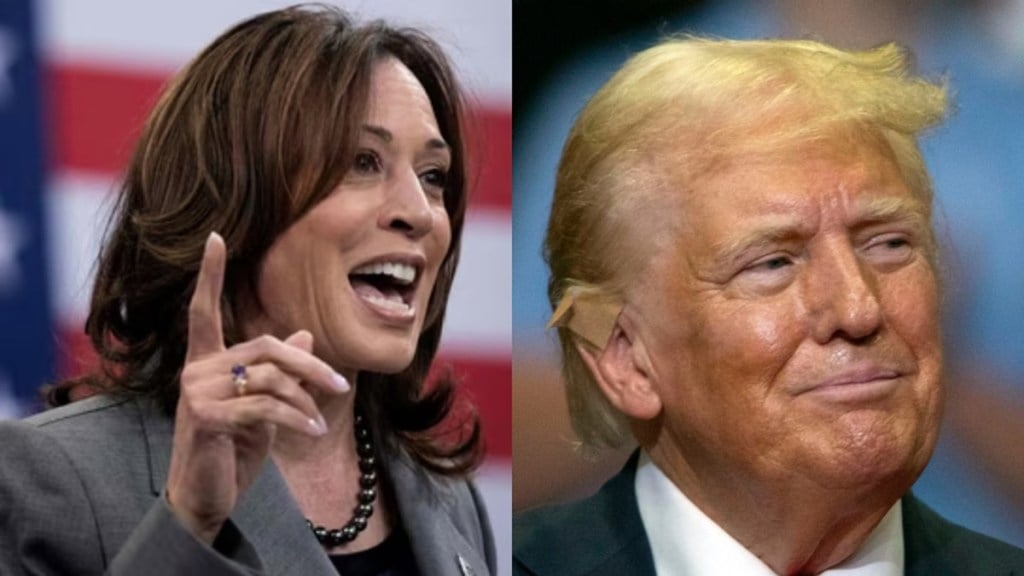On November 5, American voters will cast their ballots to decide the results of one of the most significant presidential races in modern history, with the scales tilted neither towards Kamala Harris nor Donald Trump. FE looks at how the US elections work, and why candidates can lose even if they win the popular vote
How is a presidential candidate chosen?
Unlike India, where political parties decide their candidates internally, in the US, there are primary elections or caucuses held in the states six to nine months before the election. Here, through anonymous ballots, the state’s natives decide who they want as their representatives in the national party conventions. Primaries can be open (for anyone to vote), closed (reserved only for citizens registered with the party), or hybrid. Primaries are organised by the state governments, and caucuses by the parties themselves. They can be understood as intra-party elections at the state level, wherein delegates are assigned based on the votes earned by each candidate within the party. These delegates then go on to represent the state’s citizens at the party’s national conventions. Party delegates from all 50 US states then officially nominate the presidential candidate at a national nominating convention. They choose a running mate for their campaign, who becomes the vice-president upon victory. A presidential candidate needs the vote of at least 270 electors — more than half of all electors — to win the presidential election.
What is the electoral college?
The US presidential election resembles the Indian system in the way that the 50 states are allocated electoral votes (somewhat like seats in India) based on the state’s population. However, unlike the Indian system, where elected members add to the count of the total seats of their party, the US elections mostly count the overall votes polled and in most cases, the electoral seats for the respective state are counted in the tally of the victor. The citizens do not vote for the President directly but for the electors, who are candidates appointed by each party and go on to form the electoral college. States may or may not require the names of the electors to be stated in the ballots.
How is the president elected?
Once the electors are determined, they cast their votes for the candidates of their choice. Generally, they do so based on the popular vote of their respective states; however, constitutionally, they are not required to do so. Some states might provide for such ‘faithless’ electors to be penalised and replaced. In some cases, parties may also require the electors to pledge their vote for their candidate in the electoral college. In case there is a tie within the college, the House of Representatives (the lower house of the US Congress, akin to India’s Lok Sabha) votes to elect the president. The US remains the only country which chooses its head of state who is also an executive head through this process. Such a system exists in India as well, but the president here is not the executive head.
What are battleground or swing states?
More than 90 electoral votes across Arizona, Georgia, Michigan, Nevada, North Carolina, Pennsylvania, and Wisconsin are expected to be pivotal in the presidential race. These seven swing states (just like Bihar, Maharashtra, or West Bengal, which decide the fortunes of political parties in the Lok Sabha elections in India) hold the keys to the White House, the reason why the campaigns of both Harris and Trump are courting the undecided voters in these states. These states were won by less than three percentage points in the 2020 presidential election. A mix of demographic groups, varied economic interests, and differing cultural attitudes, lead to fluctuating voter preferences from one election to the next. This time around, the immigration debate, abortion access, cost-of-living pressures are issues which have left the states undecided.
How can a candidate lose despite having won more votes?
In 2016, the US presidential race saw one of the biggest upsets in modern history, where Hillary Clinton lost to Donald Trump despite having approximately 3 million more votes. This is because the Republican ex-president had more votes in the electoral college. Another such example is the race between Republican George W Bush and Democrat Al Gore, where the latter polled almost half a million more votes. The system of the electoral college makes it such that generally, it does not matter if a candidate wins a tight race or by a landslide—it only matters that the candidate is victorious and gets allotted the state’s electors (with the exceptions being Maine and Nebraska, which allot two seats to the victor and the remaining to the candidate that wins the popular vote across the districts).
